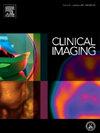The implementation of artificial intelligence in serial monitoring of post gamma knife vestibular schwannomas: A pilot study
IF 1.5
4区 医学
Q3 RADIOLOGY, NUCLEAR MEDICINE & MEDICAL IMAGING
引用次数: 0
Abstract
Background
Vestibular schwannomas (VS) are benign tumors that can lead to hearing loss, balance issues, and tinnitus. Gamma Knife Radiosurgery (GKS) is a common treatment for VS, aimed at halting tumor growth and preserving neurological function. Accurate monitoring of VS volume before and after GKS is essential for assessing treatment efficacy.
Purpose
To evaluate the accuracy of an artificial intelligence (AI) algorithm, originally developed to identify NF2-SWN-related VS, in segmenting non-NF2-SWN-related VS and detecting volume changes pre- and post-GKS. We hypothesize this AI algorithm, trained on NF2-SWN-related VS data, will accurately apply to non-NF2-SWN VS and VS treated with GKS.
Methods
In this retrospective cohort study, we reviewed data from an established Gamma Knife database, identifying 16 patients who underwent GKS for VS and had pre- and post-GKS scans. Contrast-enhanced T1-weighted MRI scans were analyzed with both manual segmentation and the AI algorithm. DICE similarity coefficients were computed to compare AI and manual segmentations, and a paired t-test was used to assess statistical significance. Volume changes for pre- and post-GKS scans were calculated for both segmentation methods.
Results
The mean DICE score between AI and manual segmentations was 0.91 (range 0.79–0.97). Pre- and post-GKS DICE scores were 0.91 (range 0.79–0.97) and 0.92 (range 0.81–0.97), indicating high spatial overlap.
Conclusion
AI-segmented VS volumes pre- and post-GKS were consistent with manual measurements, with high DICE scores indicating strong spatial overlap. The AI algorithm processed scans within 5 min, suggesting it offers a reliable, efficient alternative for clinical monitoring.
Clinical importance
DICE scores showed high similarity between manual and AI segmentations. The pre- and post-GKS VS volume percentage changes were also similar between manual and AI-segmented VS volumes, indicating that our AI algorithm can accurately detect changes in tumor growth.
人工智能在伽玛刀后前庭神经鞘瘤串行监测中的应用:一项试点研究
前庭神经鞘瘤(VS)是一种良性肿瘤,可导致听力损失、平衡问题和耳鸣。伽玛刀放射手术(GKS)是VS的常用治疗方法,旨在阻止肿瘤生长并保持神经功能。在GKS前后准确监测VS体积对于评估治疗效果至关重要。目的评估人工智能(AI)算法在分割非nf2 - swn相关VS和检测gks前后体积变化方面的准确性,该算法最初用于识别nf2 - swn相关VS。我们假设该AI算法在nf2 - swn相关VS数据上进行训练,将准确适用于非nf2 - swn VS和使用GKS处理的VS。方法在这项回顾性队列研究中,我们回顾了来自已建立的伽玛刀数据库的数据,确定了16例因VS接受GKS治疗的患者,并进行了GKS前后扫描。对比增强的t1加权MRI扫描用人工分割和人工智能算法进行分析。计算DICE相似系数来比较人工智能和人工分割,并使用配对t检验来评估统计显著性。对两种分割方法计算了gks前后扫描的体积变化。结果人工智能和人工分割的平均DICE评分为0.91(范围0.79 ~ 0.97)。gks前后的DICE评分分别为0.91(0.79 ~ 0.97)和0.92(0.81 ~ 0.97),空间重叠程度较高。结论人工智能分割的VS体积在gks前和gks后与人工测量结果一致,高DICE分数表明空间重叠性强。人工智能算法在5分钟内处理扫描,这表明它为临床监测提供了一种可靠、有效的替代方案。临床重要性ice评分显示人工分割和人工智能分割具有很高的相似性。人工和人工分割的VS体积在gks前和gks后的VS体积百分比变化也相似,表明我们的人工智能算法可以准确地检测肿瘤生长的变化。
本文章由计算机程序翻译,如有差异,请以英文原文为准。
求助全文
约1分钟内获得全文
求助全文
来源期刊

Clinical Imaging
医学-核医学
CiteScore
4.60
自引率
0.00%
发文量
265
审稿时长
35 days
期刊介绍:
The mission of Clinical Imaging is to publish, in a timely manner, the very best radiology research from the United States and around the world with special attention to the impact of medical imaging on patient care. The journal''s publications cover all imaging modalities, radiology issues related to patients, policy and practice improvements, and clinically-oriented imaging physics and informatics. The journal is a valuable resource for practicing radiologists, radiologists-in-training and other clinicians with an interest in imaging. Papers are carefully peer-reviewed and selected by our experienced subject editors who are leading experts spanning the range of imaging sub-specialties, which include:
-Body Imaging-
Breast Imaging-
Cardiothoracic Imaging-
Imaging Physics and Informatics-
Molecular Imaging and Nuclear Medicine-
Musculoskeletal and Emergency Imaging-
Neuroradiology-
Practice, Policy & Education-
Pediatric Imaging-
Vascular and Interventional Radiology
 求助内容:
求助内容: 应助结果提醒方式:
应助结果提醒方式:


